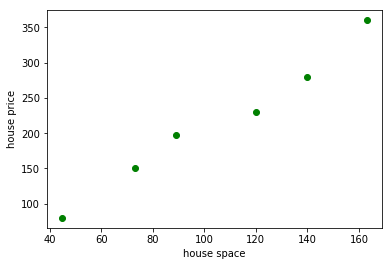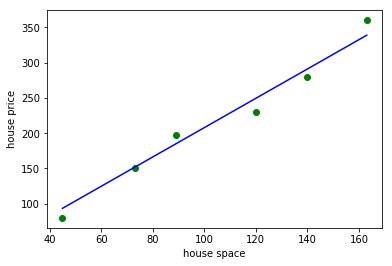python 梯度下降法
梯度下降法是机器学习算法更新模型参数的常用的方法之一。
相关概念
- 梯度 : 表示某一函数在一点处变化率最快的方向向量(可理解为这点的导数/偏导数)
- 样本 : 实际观测到的数据集,包括输入和输出(本文的样本数量用 m 表述,元素下标 i 表示)
- 特征 : 样本的输入(本文的特征数量用 n 表示,元素下标 j 表示)
- 假设函数 : 用来拟合样本的函数,记为 $h_\theta(X)$ ($\theta$ 为参数向量, X 为特征向量)
- 损失函数 : 用于评估模型拟合的程度,训练的目标是最小化损失函数,记为 $J(\theta)$
-
线性假设函数 :
其中 X 为特征向量, $\theta_j$为模型参数, $x_j$ 是特征向量的第 j 个元素(令$x_0$=1)。
-
经典的平方差损失函数如下:
其中 m 为样本个数, $X_i$ 为样本特征集合的第 i 个元素(是一个向量), $y_i$ 是样本输出的第i个元素, $h_\theta(X_i)$ 是假设函数。
注意:输入有多个特征时,一个样本特征是一个向量。假设函数的输入是一个特征向量而不是特征向量里面的一个元素
梯度下降法
梯度下降法的目标是通过合理的方法更新假设函数 $h_\theta$ 的参数 $\theta$ 使得损失函数 $J(\theta)$ 对于所有样本最小化。
这个合理的方法的步骤如下:
- 根据经验设计假设函数和损失函数,以及假设函数所有 $\theta$ 的初始值
- 对损失函数求所有 $\theta$ 的偏导(梯度): $\dfrac{\partial J(\theta)}{\partial \theta_j}$
-
使用样本数据更新假设函数的 $\theta$,更新公式为: $\theta_j = \theta_j - \alpha \cdot \dfrac{\partial J}{\partial \theta_j}$
其中 $\alpha$ 为更新步长(调整参数的灵敏度,灵敏度太高容易振荡,灵敏度过低收敛缓慢)
推导过程
线性假设函数公式如下(根据经验或者已有数据人为定义):
损失函数公式如下(根据经验或者已有数据人为定义):
其中 $\frac{1}{2}$ 是为了计算方便(可与平方的导数相乘后抵消)。
单个样本的损失函数对 $\theta$ 求偏导的流程如下:
对于所有样本的损失函数对 $\theta$ 偏导结果等于所有单个样本之和,公式如下:
其中 $X_{ij}$ 表示第 i 个样本的第 j 个特征。
对于假设函数 $\theta$ 的更新公式如下($\theta$ 的初始值需要根据经验给出):
使用所有样本作为输入重复执行上述过程,直到损失函数的值满足要求为止。
例子
这里用一个房屋价格评估的例子来使用梯度下降法。 我们知道房屋的价格跟很多因素相关(例如面积、房间书、地段等),每个因素都称之为特征(feature)。 这里假设房屋的面积是唯一特征(为简化模型而忽略其他的),已知的数据如下:
房屋面积: 45, 73, 89, 120, 140, 163 (平方米)
房屋价格: 80, 150, 198, 230, 280, 360 (万元)
根据这些数据可以使用下面的 python 代码做出面积和价格的三点图。
%matplotlib inline
import numpy as np
import matplotlib.pyplot as plt
spaces = [45, 73, 89, 120, 140, 163]
prices = [80, 150, 198, 230, 280, 360]
spaces, prices = np.array(spaces), np.array(prices)
plt.scatter(spaces, prices, c='g')
plt.xlabel('house space')
plt.ylabel('house price')
plt.show()
## 显示房屋面积和房屋价格的散点图

根据梯度下降法的步骤我们需要先给定假设函数 $h_\theta$ 和损失函数 $J(\theta)$,以及初始 $\theta$ 值。
这里房屋面积和价格的假设函数为: $h_\theta(x) = \theta_0 + \theta_1 x$ (一个特征)
损失函数使用平均方差函数: $J(\theta) = \dfrac{1}{2*6} \sum_{i=1}^6(h_\theta(X_i) - y_i)^2$ (6个样本)
假设更新步长为 0.00005, 则更新公式为 $\theta_j = \theta_j - 0.00005 \cdot \dfrac{1}{6} \sum_{i=1}^6 (h_\theta(X_i) - y_i) \cdot X_{ij} $
其中 $\theta_j$ 包含 $\theta_0$ 和 $\theta_1$ , $X_{i0}$ = 1。
注意: 如果步长选择不对,则 theta 参数更新结果会不对
使用下面 python 代码计算 $\theta$ 并画出 $h_\theta$ 函数 :
%matplotlib inline
import numpy as np
import matplotlib.pyplot as plt
## theta 初始值
theta0 = 0
theta1 = 0
## 如果步长选择不对,则 theta 参数更新结果会不对
step = 0.00005
x_i0 = np.ones((len(spaces)))
# 假设函数
def h(x) :
return theta0 + theta1 * x
# 损失函数
def calc_error() :
return np.sum(np.power((h(spaces) - prices),2)) / 6
# 损失函数偏导数( theta 0)
def calc_delta0() :
return step * np.sum((h(spaces) - prices) * x_i0) / 6
# 损失函数偏导数( theta 1)
def calc_delta1() :
return step * np.sum((h(spaces) - prices) * spaces) / 6
# 循环更新 theta 值并计算误差,停止条件为
# 1. 误差小于某个值
# 2. 循环次数控制
k = 0
while True :
delta0 = calc_delta0()
delta1 = calc_delta1()
theta0 = theta0 - delta0
theta1 = theta1 - delta1
error = calc_error()
# print("delta [%f, %f], theta [%f, %f], error %f" % (delta0, delta1, theta0, theta1, error))
k = k + 1
if (k > 10 or error < 200) :
break
print(" h(x) = %f + %f * x" % (theta0, theta1))
# 使用假设函数计算出来的价格,用于画拟合曲线
y_out = h(spaces)
plt.scatter(spaces, prices, c='g')
plt.plot(spaces, y_out, c='b')
plt.xlabel('house space')
plt.ylabel('house price')
plt.show()
# 绿色的点是房屋面积和价格数据
# 蓝色的线是我们使用梯度下降法拟合出来的曲线
h(x) = 0.016206 + 2.078464 * x

通过运行上述代码,我们可以看出,梯度下降法的结果跟 $\theta$ 的初始值以及步长相关。 我们需要根据系统的特性凭经验给出 $\theta$ 和步长。
对于多特征系统来说,其实就是 $h_\theta$ 的改变而已,如果使用矩阵形式表示的话会更加方便。
假设函数向量形式(其中X是二维矩阵 m 行 n 列):
损失函数向量形式(其中 Y 是 m 行 1 列的样本输出):
$\theta$ 向量更新形式,令
我们改进一下上述 python 代码,使用矩阵处理以适应多特征系统并得出一样的结果。
注意: 用矩阵公式表示的时候没有除以样本数,实际写代码要除以样本数
%matplotlib inline
import numpy as np
import matplotlib.pyplot as plt
## 输入数据格式:
## 1. 一个特征的是一维数组,表示样本
## 2. 多个特征的是二维数组,列表示特征数,行表示样本数
spaces = np.array([45, 73, 89, 120, 140, 163])
prices = np.array([80, 150, 198, 230, 280, 360])
# 步长
step = 0.00005
## 先计算输入的特征个数, 然后根据特征数生成 theta,并在样本数据前面插入一列全1数据
def genrate_model(inputs) :
_features = 2
_samples = inputs.shape[0]
if len(inputs.shape) == 2 :
_features = inputs.shape[2] + 1
_x0 = np.ones(_samples)
_theta = np.zeros(_features)
return np.c_[_x0, inputs], _theta, _samples
## 假设函数:输入数据矩阵与theta向量向乘, 返回多项式结果的一维矩阵
def h_a(x) :
return (theta * x).sum(axis=1)
## 损失函数
def e_a(x,y) :
return np.sum(np.power((h_a(x) - y),2)) / m
## delta函数:计算偏导乘以补偿
def delta_a(x, y) :
return step * ((h_a(x) - y) * np.transpose(x)).sum(axis=1) / m
## 系统的特征数 + 1
x_data, theta, m = genrate_model(spaces)
y_data = prices
## 重新计算 delta 并更新 theta
k = 0
while True:
_d = delta_a(x_data, y_data)
theta = theta - _d
error = e_a(x_data, y_data)
# print("delta", _d, "theta ", theta , ", error ", error, "k ", k)
k = k + 1
if (k > 10 or error < 200) :
break;
# 打印 theta 结果,可以看出与上面 python 代码计算的结果是一致的。
print("theta array : " , theta)
theta array : [ 0.01620597 2.07846445]
注意点
- 对于凸函数来说 $\theta$ 的初始值多少关系不大,对于非凸函数的初始值选择不当会陷入局部最优解
- 梯度下降的步长取决于样本数据,根据实际运行效果进行调整
- 误差最小值也是跟数据相关的,需要根据实际情况给定结束条件
-
对于多个特征值的系统,需要使用 z-score 方法对数据进行归一化,公式如下:
分类
根据更新 $\theta$ 时使用样本的数量对梯度下降法进行分类:
- 批量梯度下降法(BGD):使用所有样本进行计算,慢但准确度好
- 随机梯度下降法(SGD):每次使用1个样本进行计算,快但准确度欠缺
- 小批量梯度下降法:每次使用a个样本进行计算,是BGD和SGD的折中方案
转载请注明出处: http://blog.lisp4fun.com/2017/11/02/gradient-desent